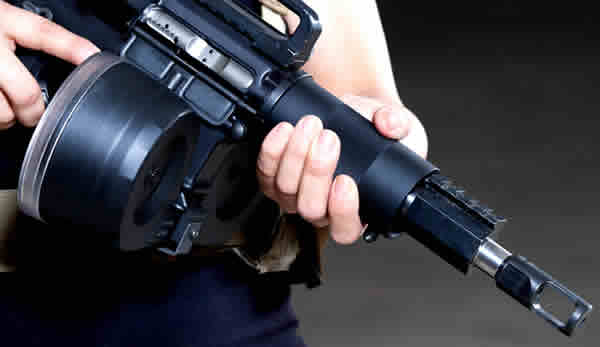Best Adjustable Gas Block
Why You Need An Adjustable Gas Block
Story and Photographs by Brian Hormberg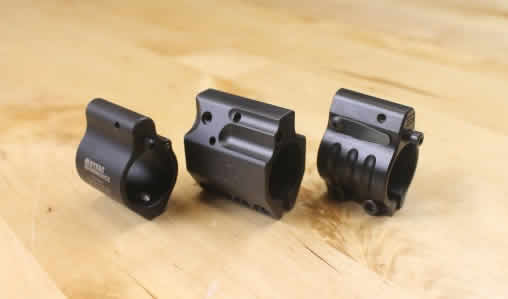
Did you know that replacing the factory gas block on your AR-15 with an adjustable gas block can improve your rifle’s performance? Such as:
- Less recoil, results in a faster follow-up shot
- Less stress on the operating parts
- Less carbon build-up, better reliability and easier cleaning
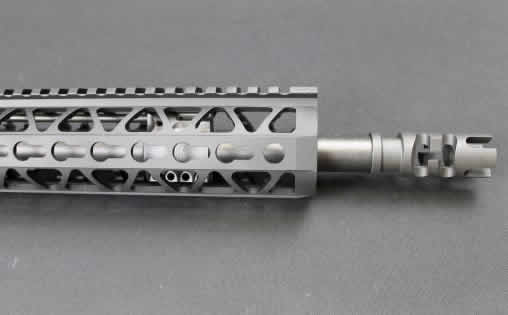
What is a Gas Block?

The typical factory gas block is pinned onto the barrel in front of the polymer handguard as part of the front sight assembly. If your rifle features a free-float aluminum handguard, then the gas block is typically a low-profile type that fits under that handguard. The job of the gas block is to take some of the hot gas from behind the bullet that comes through a gas port in the barrel, and direct it into the gas tube which drives the bolt carrier and cycles the action.
Most gas blocks on factory AR-15s are fixed, meaning they just provide a path for the gas from the barrel to the gas tube. With a fixed gas block, all the gas and pressure that comes out of the gas port in the barrel will be used to cycle the action.
In most AR-type rifles there is intentionally more gas than needed, so that if the gun gets dirty, it will continue to cycle.
But often this overgassed situation is more than is really needed, adding to the recoil and increasing wear on parts. That’s where adjustable gas blocks come in. They provide a way to cut off a portion of the gas flow so the action can be driven less forcefully.
The Gas Block History

The concept of an adjustable-gas system has been around for quite a while. Competition shooters using M1 Garand rifles, a semiauto first used in the US military in 1936, found utility in adjustable gas plugs to regulate the cycling of the action by letting out a little extra gas.
Perhaps the most prolific use was in the FN-FAL (Fabrique Nationale-Fusil Automatique Légerseries, a Belgium manufacturer) rifles developed after World War II. On the FNs, the amount of gas released out of the gas cylinder as the piston was cycling could be adjusted by hand, which controlled how much gas pressure was applied to the piston.
This is similar to what the M1 competition shooters were doing with their adjustable gas plugs.
The normal procedure is to tune down the gas pressure until the gun doesn’t fully cycle, then tune it up one click at a time until it cycles reliably, then go a few clicks further for reliability and you’ll be in the optimal zone. This way the gun is reliable with the least amount of recoil and stress possible, and it can be tuned to a specific type of ammunition as well.
Gas Blocks Today
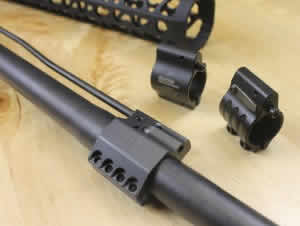
This same concept is now being applied to the AR-15 and AR-10 family of rifles with modern adjustable gas blocks. The difference is on an AR-15 the gas adjustment cuts off some of the gas flow coming from the barrel instead of letting more of it out after it passes through the gas block, as on the FN-FAL and M1. Early adjustable gas blocks on AR-15s simply used a small metering screw on the side of the gas block that cut off gas flow as you screwed it in. The further you screwed it in, the less gas flow there was.
Once adjusted, the screws were kept in place either by using Loctite or by just letting some carbon build up on the screw to hold it in place. This worked pretty well in practice and has been used by AR-15, 3-Gun shooters for years, but didn’t gain wide acceptance. In the past few years new designs have emerged that have taken the concept to the next level and improved shooter appeal.
Brass locking screws have been added to ensure adjustments stay put without using Loctite, and low-profile versions have been made so they can fit under free-float forearms. Designing them to fit under most of the popular rail systems is a big plus for modern AR builders. Eventually, the desire for lockable settings was solved with spring-loaded detents that were used to lock adjustments in place with audible clicks.
This made it possible to adjust the gas block under the handguard in the field by a known amount and have it automatically lock in place. For those wanting a more mil-spec (military specification or standards) type solution, this was very appealing and has brought these adjustable gas blocks into a far wider acceptance.
The Benefits
You’re probably wondering what difference would it really make in your gun’s performance if you used one of these. Well, there are three:
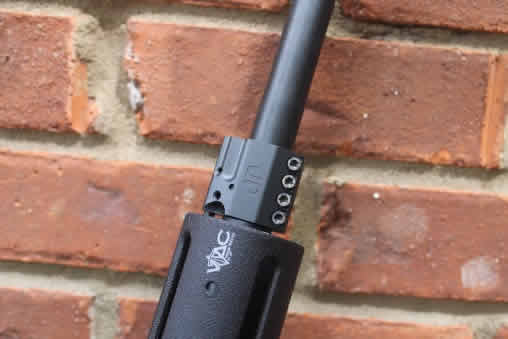
1) You can tune your rifle to run just as hard as is really needed, and by doing so you will experience less recoil and less movement of your sights off target, so your follow-up shots can be faster. What’s happening is that your bolt carrier group will cycle hard enough to extract, eject and feed reliably, but it won’t slam to a stop as hard at the rear of its stroke.
2) There will be less stress on your operating parts because they are not running any harder than necessary. It’s like running your car engine at lower revolutions per minute. Don’t worry, it will not feel slower while shooting.
3) Since you will be cutting off some of the gas going into the bolt carrier group, it’s common to get less carbon build-up in your bolt carrier and on your bolt. This will cause your gun to run cleaner, which can result in better reliability and easier cleaning.
All of these benefits are worthwhile for the shooter who wants to get all the performance possible from his or her rifle.
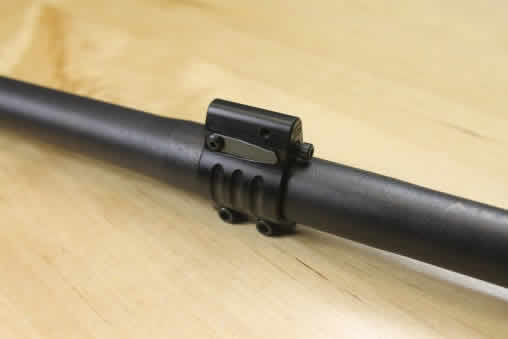
Installing
So how easy are they to install? If you are familiar with AR builds and installing gas blocks, then installing one of these is the same thing.
For those unfamiliar, it will require removing your flash hider or muzzle brake, removing your handguard, unpinning and removing your factory gas block and installing the new one using set screws or clamping screws to lock it into place. Then you reinstall your handguard and muzzle device. These days, with all the AR-15 home builders out there, this is pretty common knowledge, and the skills required are basic-level gunsmithing.
If you aren’t comfortable with this, find a reputable gunsmith who is proficient in AR builds; this will be an inexpensive gunsmithing job. There is no fitting required; it just involves taking off some parts and then reinstalling some parts. Adjustable gas blocks can be installed on any AR-15 or AR-10 rifle of any caliber or barrel length, as long as it uses a standard gas tube system. ASJ
Editor’s note: Brian Hormberg is the owner of Para Bellum Products, Inc. You can visit the company’s website at nokick.com or follow his blog at ontarget-blog.com.
The Pioneers
By Brian Hormberg
One of the pioneers in the adjustable gas block concept is JP Enterprises, a well-known manufacturer of top-of-the-line race guns for 3-Gun competition. They made an entire system of it by combining adjustable gas blocks with low-mass bolt carriers and low-mass buffers. This concept called for lower reciprocating mass in the moving parts which needed lower gas pressure to run at the right speed. Adjustable gas blocks made this concept possible. The result is even less movement of the gun during firing and even faster recovery from the shot, which is a big advantage in competition. Low-mass systems are normally recommended for competition guns versus duty guns, since a full-mass system can run better when really dirty.
JP makes their adjustable gas blocks in several formats, including ones with rails on top of the gas block, fixed front-sight models, and low-profile units with lock screws that go under handguards. Syrac Ordnance and SLR Rifleworks are two companies that have recently introduced low-profile, click-adjustable models that can be easily adjusted from the front under the forearm. These are especially well suited to those who want a quick, predictable gas setting change when they switch from subsonic to supersonic or when going from suppressed to unsuppressed. The Syrac Ordnance model is completely self-contained, while the SLR Rifleworks model is designed for easy disassembly and cleaning. Both are small enough to fit under the thinnest aluminum forearm systems.
Another recent trend is to offer this same capability in a piston-driven format in addition to the more common direct gas design. If you like the idea of a piston-driven operating system and like the idea of adjustable gas settings, you can now have both together. The adjustable piston systems can be retrofitted to existing AR-15s or included in new builds just like the other gas blocks and provide the same advantages. The adjustable piston systems include a gas block, gas piston and a complete bolt-carrier group, in addition to the gas block itself to ensure compatibility. Low-profile versions are now in production from Adams Arms and Syrac Ordnance, and which allow you to fit an adjustable gas piston system under a wider selection of rail forearms than ever before possible and with the adjustment capability.
As more shooters become aware of the advantages of adjustable gas systems, they will likely continue to increase in popularity. All of this is another example of the incredibly wide selection of parts, designs and options available to today’s AR shooter. The operation and performance of the rifle can be customized and tuned to an amazing level, and is only limited by your imagination.
Here’s some tips for tuning your AR-15 adjustable gas block from Jesse Tishcauser of Optics Planet.

Midwest Industries Micro Gas Block – $39.99
Theow-profile design of Midwest Industries® Micro Gas Block allows placement under most commercially available drop-in and free-floated handguards. Constructed of ultratough 4041 steel, the 1.125 block secures with 2 set screws. Fits .750 bar.


Wheeler Engineering Delta Series AR Gas Block Taper Pin Removal Tool – $39.99
Remove A2-style gas blocks from your tactical rifle quickly and easily with the Wheeler Engineering® Delta Series AR Gas Block Taper Pin Removal Tool. Constructed of precision-machined steel, this tool is equipped with starter and finishing punc.




